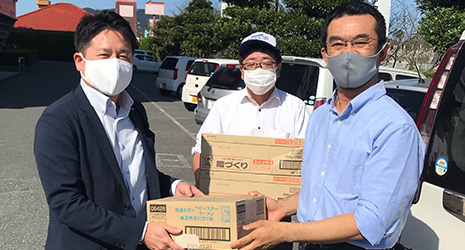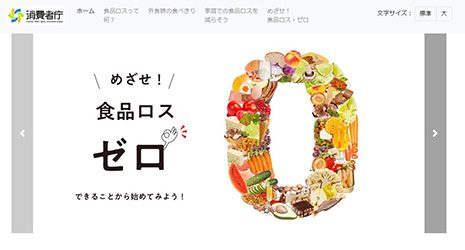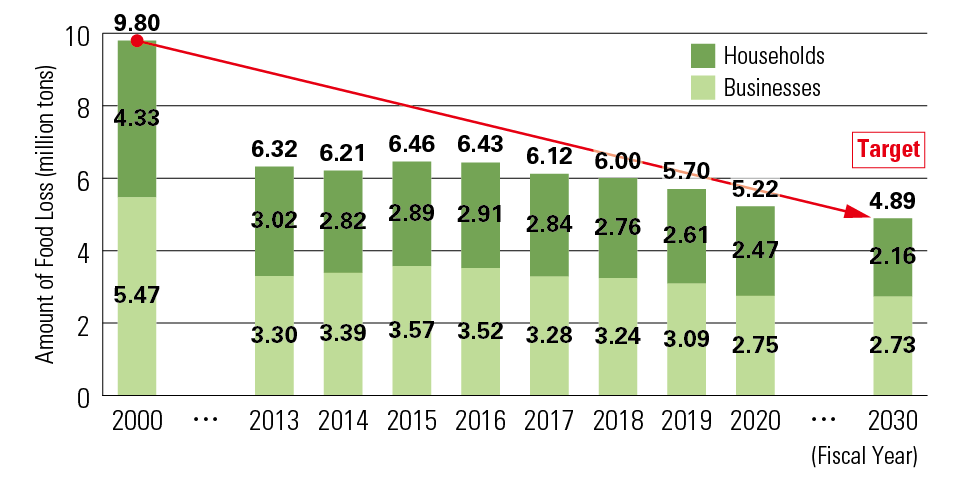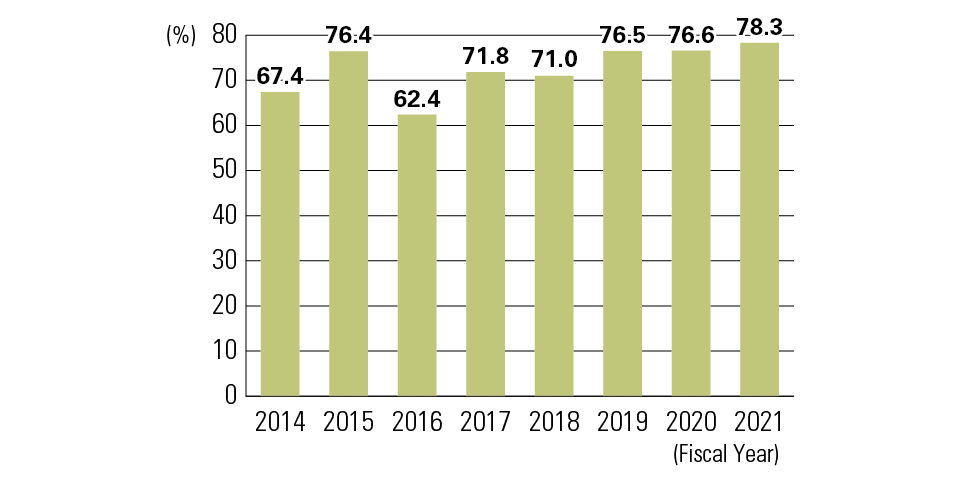September 2022
- English
- 日本語
Initiatives to Reduce Food Loss and Waste

Nippon Access donating food to a food bank 
The Consumer Affairs Agency has established a special website regarding food loss and waste for consumers to raise awareness

Poster raising awareness of Food Loss and Waste Reduction Month 2022. When Japan’s food loss and waste (5.22 million tons per year) is expressed on a per capita basis, then each person in the population throws away around a bowl of rice (about 113 grams) every day

Japan is implementing a range of initiatives to reduce food loss and waste (FLW) through cooperation among national and local governments, businesses, and consumers.

The term “food loss and waste” refers to leftover food, unsold food and any other food that is fit for consumption but which, for various reasons, ends up being thrown away. According to statistics published by the Ministry of the Environment (MOE) and the Ministry of Agriculture, Forestry and Fisheries (MAFF) of the Japanese government, in FY2020, the food loss and waste generated in Japan amounted to around 5.2 million tons. Of this, 53% (2.75 million tons) was generated by businesses in industries such as the food service and food manufacturing industries, and 47% (2.47 million tons) was generated by households.
A report by the United Nations Food and Agriculture Organization (FAO) suggests that of the food produced for human consumption each year (about 4 billion tons), roughly one-third is lost or wasted globally, which amounts to about 1.3 billion tons per year
Throwing away vast amounts of food like this has various impacts on society, such as increased disposal costs, as well as knock-on effects for the environment, including an increase in emissions of CO2 from waste incineration and an increase in landfill sites for incineration ash. For these reasons, one of the targets of the Sustainable Development Goals (SDGs) adopted by the United Nations in 2015 sets, “By 2030, halve per capita global food waste at the retail and consumer levels and reduce food losses along production and supply chains, including post-harvest losses.”
Initiatives in Japan
The Japanese Government has set a target of halving Japan’s food loss by 2030 from the 9.8 million tons recorded in 2000. To achieve this goal, a range of initiatives are being implemented in Japan. A key pillar underpinning such initiatives is the Act on Promotion of Food Loss and Waste Reduction, which came into force in October 2019. The act was enacted to encourage diverse entities, including national and local governments, businesses, and consumers, to work together to reduce food loss and waste. It sets October as Food Loss Reduction Month to increase understanding and interest in reducing food loss and waste, obligates the national government to establish a basic policy to cut back on food loss and waste, and stipulates that national and local governments are to educate and raise awareness among businesses and consumers.
In light of the act, one initiative that is a focus of national government efforts is the dissemination of information. The Consumer Affairs Agency (CAA) has established a special website regarding food loss and waste reduction for consumers, which provides basic information about food loss and waste, and a range of other information such as tips and ideas for reducing food loss and waste at home. MAFF also established a portal site for providing the national government’s emergency food stockpiles to food banks and others with a view to reducing food loss and waste, and supporting vulnerable people. In Japan, natural disasters such as typhoons and earthquakes occur frequently and so each ministry and agency stockpiles preserved pregelatinized rice, drinking water, canned food and other supplies. By gathering information about food stockpiled by each ministry or agency that is near its “best-before date”* and publishing this information on the portal site, MAFF makes it easier for food banks and other organizations to obtain stockpiled food.
Furthermore, to generate momentum for the reduction of food waste throughout Japan, national and local governments have jointly organized the Food Loss and Waste Reduction National Convention, which has been held on October 30 every year since 2017 (except for 2020 when it was held in December). In addition to seminars and talk sessions, the convention has also featured the Food Loss Reduction Promotion Awards run by the CAA and the MOE since 2020. The awards are presented by the Ministers of State and others to businesses, schools and individuals who have been outstanding in their commitment to reducing food loss and waste. Award winners in FY2021 included general food wholesaler Nippon Access, Inc., which implemented initiatives such as improving the food ordering process, providing food to food banks and introducing an AI-based food demand forecasting system. Through these initiatives, Nippon Access reduced food loss by almost 300 tons per year. Another winner, Food Loss Reborn Center, focusses on food recycling, picking up emergency food supplies that are near their best-before date stockpiled by local governments and businesses, and donating them to cafeterias for disadvantaged children, food banks and similar organizations. The center is also engaged in an initiative to turn stockpiles of emergency food supplies that are past their best-before dates or in a bad state of preservation into animal feed. Pupils in fourth-year class 4 of Osaka Elementary School in Kamakura City, Kanagawa Prefecture were also recognized for their initiative to reduce school lunch leftovers, which included producing posters to promote the reduction of food waste and calling on pupils to get behind the initiative. As a result, school lunch leftovers across the whole school were significantly reduced, down from an average of 15 kilograms a day to 200 grams.

In recent years, public awareness of food loss and waste reduction has grown. According to a survey by the CAA, the percentage of people engaged in some sort of action to reduce food loss increased from 67.4% in FY2014 to 78.3% in FY2021. The government aims to increase this figure to 80% or more by FY2025. It is action on the part of every individual that will help further reduce food loss and waste.
Note: This article has been created with the consent of the Consumer Affairs Agency and on the basis of materials published by the Agency.


* According to the CAA, the best-before date does not mean that the food is no longer edible after this date; rather it means the date until which the product can be eaten deliciously. The best-before date is the date until which all the expected quality of the product is deemed sufficiently likely to be preserved if stored according to the specified storage method.

